 W
WThe so-called Bars of Aragon, Royal sign of Aragon, Royal arms of Aragon, Four Bars, Red Bars or Coat of arms of the Crown of Aragon, which bear four red paletts on gold background, depicts the familiar coat of the Kings of Aragon. It differs from the flag because this latter uses fesses. It is one of the oldest coats of arms in Europe dating back to a seal of Raymond Berengar IV, Count of Barcelona and Prince of Aragon, from 1150.
 W
WThe coat of arms of the Cape Colony was the official heraldic symbol of the Cape Colony as a British colony from 1875 to 1910, and as a province of South Africa from 1910 to 1994.
 W
WThe coat of arms of Castile was the heraldic emblem of its monarchs. Historian Michel Pastoureau says that the original purpose of heraldic emblems and seals was to facilitate the exercise of power and the identification of the ruler, due to they offered for achieving these aims. These symbols were associated with the kingdom, and eventually also represented the intangible nature of the national sentiment or sense of belonging to a territory.
 W
WThe coat of arms of the city of Gdańsk, in its current form, dates back to 1410 and Banderia Prutenorum. The coat of arms is very similar to the flag of Gdańsk. It depicts two silver crosses on a red shield above each other, above which hovers a golden crown. The greater arms also has two lions as supporters and Gdańsk motto.
 W
WThe coat of arms of Gran Colombia was adopted in 1821.
 W
WThe coat of arms of Czechoslovakia were changed many times during Czechoslovakia’s history, some alongside each other. This reflects the turbulent history of the country and a wish to use appropriate territorial coats of arms.
 W
WThe national emblem of East Germany featured a hammer and a compass, surrounded by a ring of rye. It was an example of what has been called "socialist heraldry". It was the only heraldic device of a European socialist state with a ring of grain which does not contain a red star.
 W
WThe royal arms of England are the arms first adopted in a fixed form at the start of the age of heraldry as personal arms by the Plantagenet kings who ruled England from 1154. In the popular mind they have come to symbolise the nation of England, although according to heraldic usage nations do not bear arms, only persons and corporations do. The blazon of the arms of Plantagenet is: Gules, three lions passant guardant in pale or armed and langued azure, signifying three identical gold lions with blue tongues and claws, walking past but facing the observer, arranged in a column on a red background. Although the tincture azure of tongue and claws is not cited in many blazons, they are historically a distinguishing feature of the arms of England. This coat, designed in the High Middle Ages, has been variously combined with those of the Kings of France, Scotland, a symbol of Ireland, the House of Nassau and the Kingdom of Hanover, according to dynastic and other political changes occurring in England, but has not altered since it took a fixed form in the reign of Richard I of England (1189–1199), the second Plantagenet king.
 W
WOver its long history, the Holy Roman Empire used many different heraldic forms, representing its numerous internal divisions.
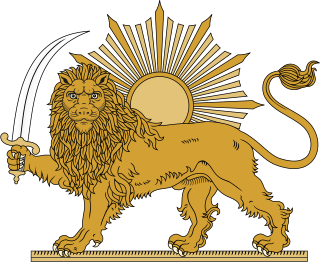 W
WThe Lion and Sun is one of the main emblems of Iran (Persia), and was an element in Iran's national flag until the 1979 Iranian Revolution. The motif, which illustrates ancient and modern Iranian traditions, became a popular symbol in Iran in the 12th century. The lion and sun symbol is based largely on astronomical and astrological configurations: the ancient sign of the sun in the house of Leo, which itself is traced back to Babylonian astrology and Near Eastern traditions.
 W
WThe coat of arms of Napoleonic Italy was the coat of arms used by the Kingdom of Italy (1805–1814) during the reign of Napoleon as King of Italy.
 W
WThe Kalmar Union was the personal union of the kingdoms of Denmark, Norway and Sweden during the 15th century. The first king of the Kalmar Union was Eric of Pomerania. His seal combined the coats of arms of Norway, Denmark, Sweden and Pomerania, and in addition the Three Crowns symbol in sinister chief; the latter heraldic design predates the Kalmar Union, and is now mostly associated with the coat of arms of Sweden, but which during the 15th century came to represent the three kingdoms of the union.
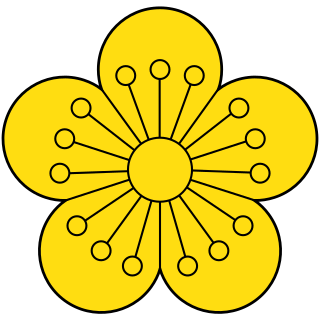 W
WThe Imperial Seal of Korea or Ihwamun was one of the symbols of the Korean Empire. It was originally the emblem of the royal family and was subsequently used for the coat of arms of the short-lived empire. The symbol features a plum flower. Today, the seal is used as a symbol by the families' association of the Jeonju Yi clan, which was the royal family of Joseon dynasty and the imperial family of the Korean Empire.
 W
WThe badge of the British Leeward Islands was adopted in the 1870s.
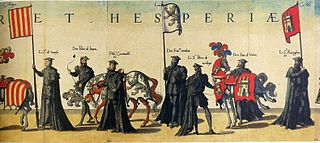 W
WThe first instance of a figure of the lion as symbol of the Kingdom of León is found in minted coins of Alfonso VII, called the Emperor (1126-1157). Until then, the cross had a preponderant position on documents and coins of Leonese monarchs since that reign the cross was gradually displaced by the lion. The Spanish historian and heraldist Martín de Riquer explained that the lion was already used as heraldic emblem in 1148. At the end of the reign of Alfonso VII, the figure of this animal began to appear on royal documents as personal device of the monarch and became pervasive during reigns of Ferdinand II (1157-1188) and Alfonso IX (1188-1230).
 W
WThe flag and coat of arms of Moldavia, one of the two Danubian Principalities, together with Wallachia, which formed the basis for the Romanian state, were subject to numerous changes throughout their history.
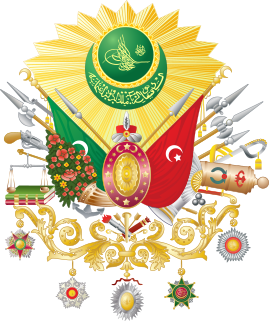 W
WEvery sultan of the Ottoman Empire had his own monogram, called the tughra, which served as a royal symbol. A coat of arms in the European heraldic sense was created in the late 19th century. Hampton Court requested from the Ottoman Empire a coat of arms to be included in their collection. As the coat of arms had not been previously used in the Ottoman Empire, it was designed after this request, and the final design was adopted by Sultan Abdul Hamid II on 17 April 1882.
 W
WCoat of arms of Congress Poland was the symbol of the Congress Poland, representing the domination of the Russian Empire over the Crown of the Polish Kingdom. It combined their previously separate coats of arms:
 W
WThe Coat of Arms of the Polish–Lithuanian Commonwealth was the symbol of the Polish–Lithuanian Commonwealth, representing the union of the Crown of the Polish Kingdom and Grand Duchy of Lithuania.
 W
WThe current coat of arms of Zimbabwe was adopted on 21 September 1981, one year and five months after the national flag was adopted. Previously the coat of arms of Zimbabwe was identical to the former coat of arms of Rhodesia.
 W
WThe coat of arms of the Federation of Rhodesia and Nyasaland was designed by M.J. Morris and was granted by Royal Warrant on 22 July 1954.
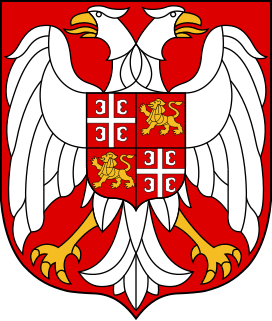 W
WThe coat of arms of Serbia and Montenegro consisted of a shield with the Serbian eagle and the shield with a quartering the Serbian cross and the Montenegrin lion passant. This emblem had served as the national symbol of the State Union of Serbia and Montenegro.
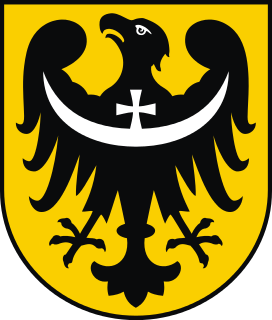 W
WThe coat of arms of Lower Silesia, and simultaneously of Silesia, shows a black eagle with silver crescent with cross in the middle on its chest on a golden background. It has been assumed in the tradition that the coat of arms and colors of Lower Silesia are simultaneously used as symbols of Silesia as a whole.
 W
WThe emblems of the constituent republics of the Union of Soviet Socialist Republics all featured predominantly the hammer and sickle and the red star that symbolised communism, as well as a rising sun, surrounded by a wreath of wheat. The USSR State motto, Workers of the world, unite!, in both the republic's language and Russian was also placed on each one of them. In addition to those repetitive motifs, emblems of many Soviet republics also included features that were characteristic of their local landscapes, economies or cultures.
 W
WThe State Emblem of the Soviet Union was adopted in 1923 and was used until the dissolution of the USSR in 1991. Although it technically is an emblem rather than a coat of arms, since it does not follow traditional heraldic rules, in Russian it is called герб, the word used for a traditional coat of arms.
 W
WThe flag and coat of arms of Transylvania were granted by Maria Theresa in 1765, when she established a Grand Principality within the Habsburg Monarchy. While neither symbol has official status in present-day Romania, the coat of arms is marshalled within the national Romanian arms; it was also for decades a component of the Hungarian arms. In its upper half, it prominently includes the eagle, which may have been one of the oldest regional symbols, or is otherwise a localized version of the Polish eagle. Early versions of the Transylvanian charges were first designed in Habsburg Hungary at some point before 1550, and were therefore symbols of pretence.
 W
WThe Emblem of East Turkestan was adopted on 12 November 1933, when the Islamic Republic of East Turkestan declared independence. After the fall of the Islamic Republic, it became a symbol of the East Turkestan independence movement.
 W
WThe coat of arms used by the United Arab Republic featured the Pan-Arab colours of the flag of the United Arab Republic on a shield carried by the Eagle of Saladin. Below, a green scroll has the Arabic text for "United Arab Republic" الجمهورية العربية المتحدة al-Ǧumhūriyyah al-ʿArabiyyah al-Muttaḥidah.
 W
WThe coat of arms of the West Indies Federation was used between 1958 and 1962. The background of the shield bore four equally spaced narrow white stripes with a ten orange-gold discs representing each island grouping, undulating horizontally across a blue field representing the Caribbean Sea and the sun shining upon the waves. These devices were based upon the flag originally designed by Edna Manley. A triangle is superimposed on the shield, and the shield is topped by a British lion. The scroll beneath proclaims To Dwell Together In Unity. The shield is supported on either side by the country's national bird, the pelican, with wings extended. Above this is a helmet topped with a flaming torch held by an upright arm. The torch signifies a beacon to light a path.
 W
WThe coat of arms of the Governor-in-chief of the British Windward Islands was adopted in 1886.
 W
WThe emblem of Yugoslavia featured six torches, surrounded by wheat with a red star at its top, and burning together in one flame; this represented the brotherhood and unity of the six federal republics forming Yugoslavia: Bosnia and Herzegovina, Croatia, Macedonia, Montenegro, Serbia and Slovenia. The date imprinted was 29 November 1943, the day the Anti-Fascist Council for the National Liberation of Yugoslavia (AVNOJ) met in Jajce on its second meeting and formed the basis for post-war organisation of the country, establishing a federal republic. This day was celebrated as Republic Day after the establishment of the republic. The emblem of Yugoslavia, along with those of its constituent republics, are an example of socialist heraldry.